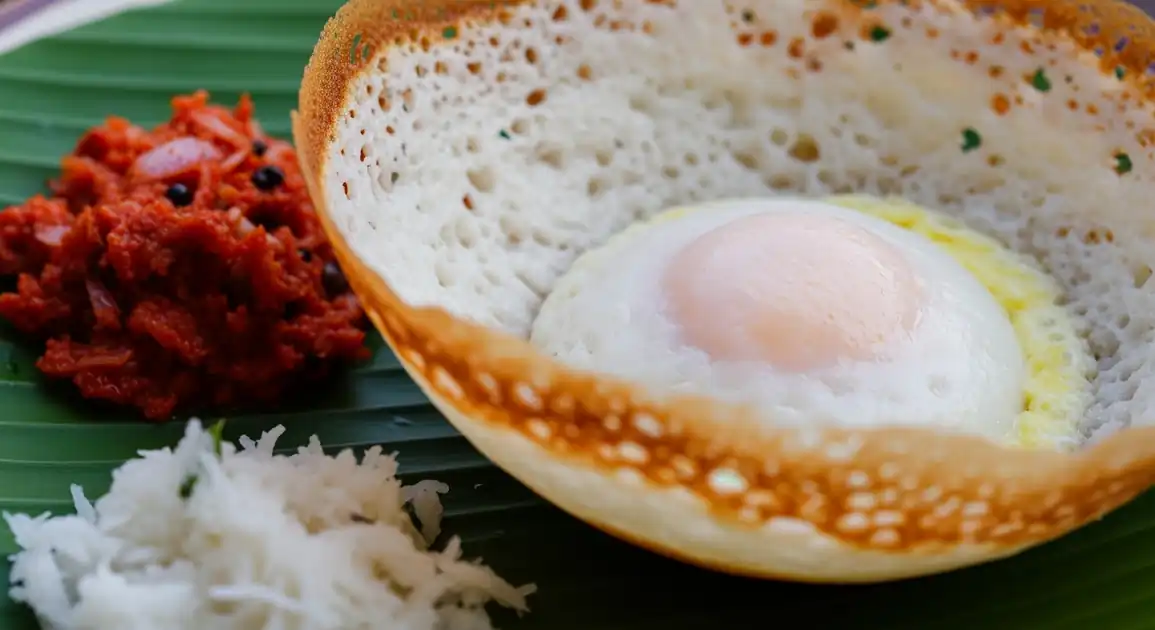Appam (Hoppers)
ආප්ප (Aappa)

Description
Colombo offers a vast array of hopper experiences, from bustling street stalls in Pettah or Galle Face Green to refined versions in high-end hotels. It's a staple dinner option for locals and a must-try for visitors.
Dietary Information
Serving information
Serving style
Street food often served on paper/plastic plates, restaurants use ceramic ware. Sambols and curries are standard accompaniments.
Quick facts
Mainly 6 PM - 10 PM for dinner trade. Breakfast 6 AM - 9 AM in certain eateries.
Safety Tips
What to Look For
-
Cooked fresh to order in front of you.
Ensures the hopper is hot, crispy, and hasn't been sitting out, minimizing contamination risk.
-
Very hot and clean 'appa thachchiya' (pan).
High heat ensures quick cooking, crisp edges, and kills bacteria. A clean pan prevents sticking and off-flavors.
-
Fresh-looking, properly fermented batter.
Batter should be white/creamy and smell slightly tangy or yeasty, not sour or discolored.
-
Vendor uses clean utensils and practices good hand hygiene.
Reduces the risk of cross-contamination, especially when handling eggs or adding sambols.
-
For Egg Hoppers: Egg is cooked through (unless requested runny and you accept the risk).
Ensures the egg is safe to eat, reducing the risk of salmonella.
What to avoid
-
Pre-cooked hoppers sitting in a pile.
They lose crispiness quickly and are exposed to contamination and temperature abuse.
-
Dirty pans with burnt residue or excessive old oil.
Affects taste and indicates poor hygiene. The small amount of oil used should look clean.
-
Batter that looks discolored, smells overly sour, or attracts flies.
Indicates the batter may be old or improperly stored.
-
Vendors with visibly poor hygiene (dirty hands, cloths).
Increases the likelihood of contaminated food.
-
Runny, undercooked eggs in egg hoppers if you are concerned about raw egg consumption.
While often preferred by locals, undercooked eggs carry a small risk. Ask for 'well-done' ('hondata pupussala') if needed.
Price information
Price range
Budget tips
- Explore areas like Pettah or Borella for very cheap street-side hoppers (50-100 LKR).
- Galle Face Green offers street food experiences, prices might be slightly higher (80-150 LKR).
- Mid-range eateries charge around 150-250 LKR per hopper with basic sambols.
- Hotel restaurants can charge 300 LKR+ per hopper.
Value indicators
- Made fresh on the spot.
- Good selection of quality sambols (Lunu Miris, Pol Sambol essential).
- Crispy edges maintained even in humid Colombo weather.
- Good balance of flavor in the hopper itself.
Where to Find This Dish
Galle Face Green
Famous evening street food spot with numerous vendors selling hoppers, especially egg hoppers.
Galle Face Hotel, Oceanfront promenade
Evening (6 PM - 10 PM)
Pettah
Find basic, cheap, and authentic hopper 'kades' catering to locals around the market areas.
Pettah Market, Manning Market, Bus Stand
Evening, Morning
Wellawatte / Bambalapitiya
Many local eateries and restaurants offering hoppers for dinner along Galle Road.
Galle Road, Majestic City, Savoy Cinema
Evening
Borella
Known for several popular local eateries serving hoppers.
Borella Junction, Supermarkets
Evening, Morning
Vendor Tips
- Galle Face Green is atmospheric but compare prices; stalls deeper inside might be cheaper.
- Look for established 'kades' with a steady stream of local customers.
- Don't be afraid to try small, busy neighborhood spots for authentic flavor.
How to Order
Regional Variations
-
Colombo-style Curries
(Colombo Curries)
Hoppers might be served with specific Colombo-style chicken or fish curries, which can differ slightly from regional variations.
-
Gourmet Hoppers
(Restaurant Hoppers)
Some upscale Colombo restaurants offer variations with non-traditional ingredients like cheese, herbs, or different types of eggs.
Cultural context
History
The origins of Appam are debated, with roots potentially in Southern India, but they have become deeply ingrained in Sri Lankan food culture for centuries. Traditionally fermented using palm toddy, modern recipes often use yeast. Hoppers evolved from a simple staple to include variations like egg hoppers and sweet versions, enjoyed across all communities in Sri Lanka.
Local significance
A democratic food enjoyed by everyone in the capital, from street food snacks to restaurant fare. Reflects the city's blend of tradition and modernity.
Eating customs
- Eating communally, ordering plates of hoppers with shared curries and sambols.
- Often paired with ginger tea ('inguru te').